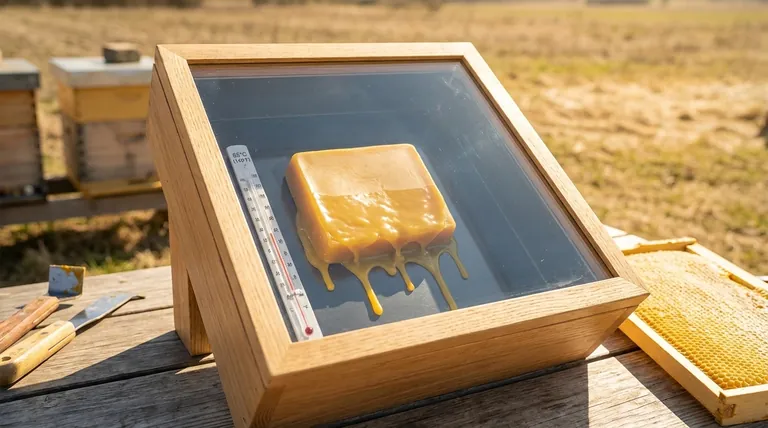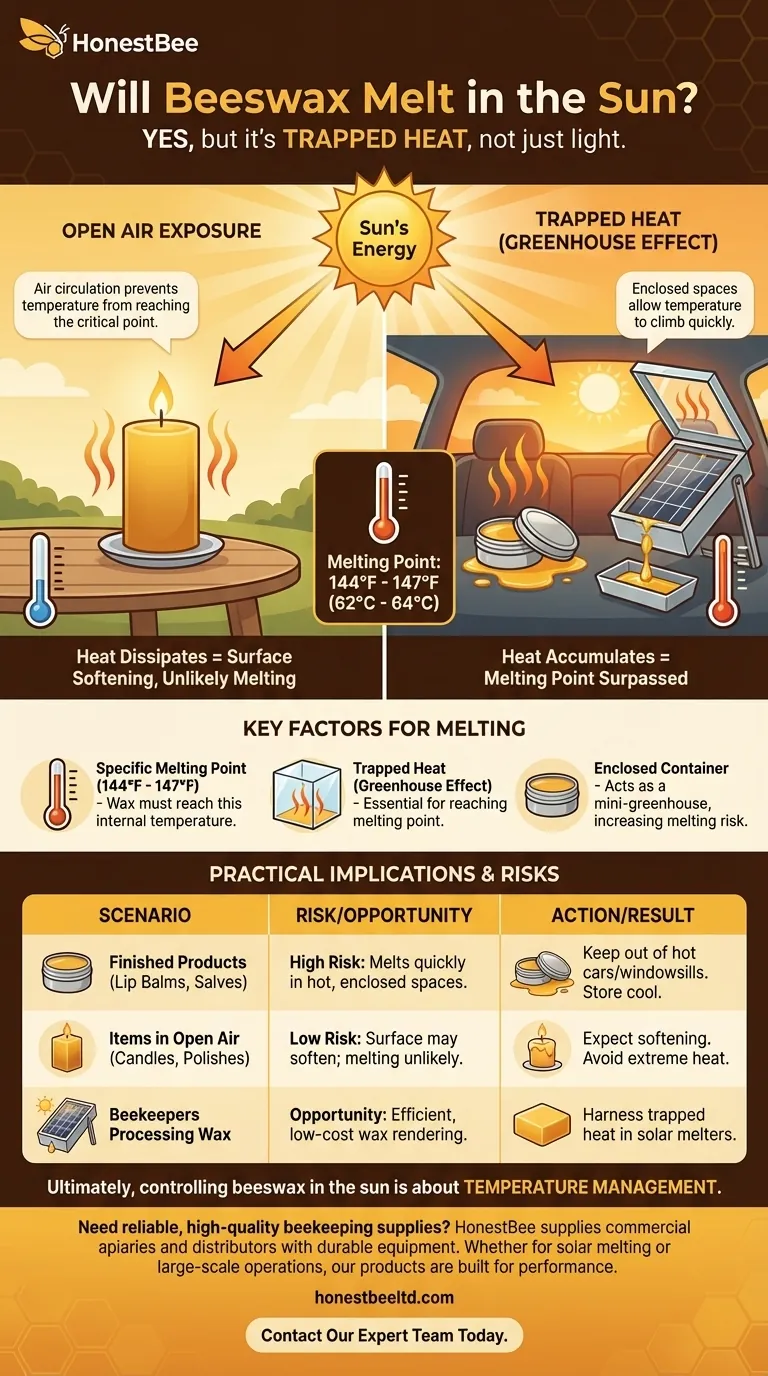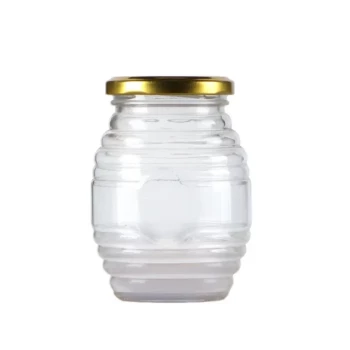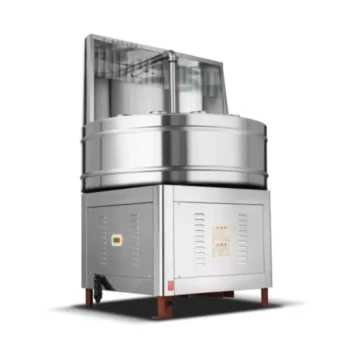Yes, beeswax will melt in the sun, but it's not the light itself that does the work. Melting occurs when the sun's energy is trapped as heat, raising the temperature of the wax and its immediate surroundings above its melting point.
The critical factor is not just sunlight, but the accumulation of heat. Beeswax only melts when its temperature surpasses approximately 145°F (62°C), a condition easily met inside an enclosed space like a solar melter or a hot car, but rarely in open air.

How the Sun Melts Beeswax
Understanding the process requires looking beyond simple sun exposure and focusing on temperature. The sun is the energy source, but the environment determines if that energy becomes intense enough to cause a physical change.
The Specific Melting Point
Beeswax isn't like ice; it doesn't melt at the first sign of warmth. It has a relatively high melting point, typically between 144°F and 147°F (62°C to 64°C).
For beeswax to melt, its core temperature must reach this specific range. Air temperature alone, even on a very hot day, is rarely sufficient to achieve this.
The Role of Trapped Heat
The sun's power is harnessed through a simple principle: the greenhouse effect. This is precisely how the solar wax melter described in the reference materials works.
An enclosed space, like a box with a glass lid, allows sunlight to enter but prevents the resulting heat from escaping. The temperature inside the box can quickly climb far higher than the outside air, easily surpassing the melting point of beeswax.
Think of the interior of a car on a sunny day. Even if it's only 80°F (27°C) outside, the car's interior can soar above 120°F (49°C), and surfaces in direct sun can get much hotter, creating conditions that will readily melt beeswax.
Practical Implications and Risks
Whether your beeswax will melt depends entirely on its location and exposure. The same product can remain solid in one scenario and liquefy in another.
For Finished Products (Lip Balms, Salves)
Products stored in small, enclosed containers are most at risk. Leaving a beeswax lip balm or a tin of salve on a car dashboard, in a hot mailbox, or on a sunny windowsill is a recipe for a melted mess.
The container itself acts as a miniature greenhouse, accelerating the heating process.
For Items in Open Air (Candles, Polishes)
A solid beeswax candle or a block of wax left outdoors in the sun is unlikely to melt into a puddle. While the surface may soften considerably and become tacky, the open air allows heat to dissipate.
Air circulation prevents the temperature from building up to the wax's critical melting point. However, extreme and prolonged heat can cause candles to slump or deform.
For Beekeepers Processing Wax
The tendency for beeswax to melt in a hot, enclosed space is a feature, not a bug. Beekeepers use simple solar wax melters to harness this principle efficiently.
Placing old combs and cappings inside a covered box in the sun is a low-cost, effective method for separating pure wax from impurities.
Making the Right Choice for Your Goal
Your approach to handling beeswax in the sun should be dictated by your intended outcome.
- If your primary focus is storing finished products: Treat them as you would chocolate—keep them out of direct sun and, most importantly, out of hot, enclosed spaces like cars.
- If your primary focus is using beeswax items outdoors: Expect some surface softening on very hot days, but complete melting is unlikely unless the item is in a container or enclosed area.
- If your primary focus is processing raw wax: Intentionally use an enclosed, dark-colored box with a clear lid to trap solar energy and efficiently melt your wax for cleaning and rendering.
Ultimately, controlling beeswax in the sun is a matter of managing its temperature by either preventing or encouraging the trapping of heat.
Summary Table:
| Factor | Detail | Impact on Melting |
|---|---|---|
| Melting Point | 144°F - 147°F (62°C - 64°C) | Wax must reach this temperature range to melt. |
| Key Mechanism | Trapped Heat (Greenhouse Effect) | Enclosed spaces (e.g., cars, solar melters) cause melting; open air rarely does. |
| Risk for Products | High in enclosed containers (lip balm tins) | Acts as a mini-greenhouse, melting wax quickly. |
| Risk for Open Items | Low for candles/blocks in open air | Air circulation prevents heat buildup; surface may soften. |
| Opportunity | Solar Wax Melting for Beekeepers | Harness trapped heat to efficiently render wax from combs. |
Need reliable, high-quality beekeeping supplies to manage your wax and your apiary?
At HONESTBEE, we supply commercial apiaries and beekeeping equipment distributors with the durable, wholesale-focused equipment they need to succeed. Whether you're processing wax with solar melters or maintaining a large-scale operation, our products are built for performance and efficiency.
Contact our expert team today to discuss your specific needs and discover how HONESTBEE can support your business's growth and productivity.
Visual Guide

Related Products
- Honey Wax Separating Wax Press with Metal Screw Wax Separator Machine
- Stainless Steel Manual Honey Press with Guard for Pressing Honey and Wax
- 10L Stainless Steel Honey Wax Press Extractor for Wax Cappings
- Professional Frame Preparation: The HONESTBEE Electric Wire Embedder
- 8-Frame Electric Self-Reversing Honey Extractor Spinner for Commercial Honey Extraction Equipment
People Also Ask
- How can remaining honey be removed from wax cappings after straining? Maximize Your Harvest Yield
- What equipment is used to separate beeswax from honey in cappings? Match the Right Tool to Your Apiary's Scale
- What is the purpose of the Wax Screw Presses set? Maximize Honey & Wax Yield Efficiently
- What are the benefits of a Honey-Wax Separating Screw Press? Boost Honey Yield & Efficiency
- What happens to the remaining wax in the Wax Screw Presses set? A Guide to Efficient Honey & Wax Separation



















